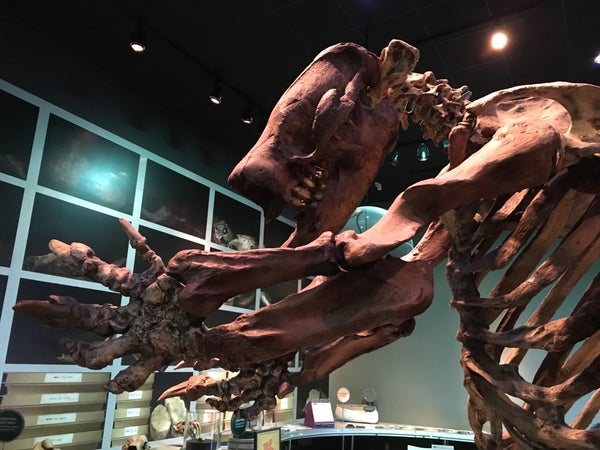This article was published in Scientific American’s former blog network and reflects the views of the author, not necessarily those of Scientific American
Sometimes, it helps to look at the evolution of science at a sloth’s pace.
In 1990, when Michael Crichton’s newly-released Jurassic Park was kept out of my grip because it was a “grown-up book,” recovering DNA from ancient, extinct organisms seemed like a distant possibility. Scraps of genetic material had been recovered from the quagga – a horse driven to extinction in the 19th century – but finding much older DNA was a scenario better suited to Crichton’s scifi.
Three decades has made a big difference. An initial wave of controversial and contested papers has given way to an entire field of ancient DNA research. (Which, admittedly, has found new ways to be controversial.) We can consider woolly mammoth coat colors, the Neanderthal genome, and sabercat DNA right from the source. We’re still no closer to resurrecting a non-avian dinosaur or even brewing up a Smilodon in the lab, but paleogenetics has rapidly gone from a distant scientific possibility to its own field.
On supporting science journalism
If you're enjoying this article, consider supporting our award-winning journalism by subscribing. By purchasing a subscription you are helping to ensure the future of impactful stories about the discoveries and ideas shaping our world today.
Science being the human-led endeavor that it is, the popularization and presentation of ancient DNA research is still very much framed around Crichton’s catalyst. The question that hangs over every well-preserved mammoth isn’t “What can we learn about how the animal lived?” but “When will we bring it back?” The prospect of de-extinction unfairly dominates the discussion of what ancient DNA might tell us, so much so that charismatic species – like Mammuthus and Neanderthals – tend to hog the spotlight.
Giant sloths usually shuffle along the sideline much as we imagine them doing during the Pleistocene. No scene is complete without them, but they are rarely front-and-center (lest an overly-aggressive Smilodon brings some drama to the scene). So consider this just one small contribution to giving sloths their due.
Sloths are not entirely extinct. As Frédéric Delsuc and 13 coauthors point out at the outset of their new study of the beasts’ genetics, there are six living sloth species belonging to two separate lineages that independently evolved to live in the trees. Their terrestrial relatives and ancestors all went extinct, and up until now figuring out who was related to whom mostly relied on skeletal anatomy. But Delsuc and colleagues turned to the mitochondrial genomes of 10 extinct sloth species to come up with a revised family tree.
Assembling the mitochondrial genomes from extinct sloths is a feat in itself – something that would have seemed outlandish 30 years ago – and this new roadmap reveals some unexpected turns. Two very different ground sloths called Parocnus and Acratocnus could be found in the Caribbean until about 4,400 years ago and were thought to have some connection to today’s two-fingered sloths. But the genetic results indicate that these sloths diverged from a much older common ancestor that was like the giant North American ground sloth Mylodon.
Today’s three-toed sloths popped up in a surprising place, too. In the past, these sloths were thought to be separate from all other sloths in what experts call a “sister group.” This basically means they were sloths, but didn’t group with any others, and so form an outside lineage. But the new study found that three-toed sloths belong to the same family as the famous Megatherium and Megalonyx. Today’s sluggish, bandit-masked three-toed sloths belong to a group that contains some of the largest ground sloths of all time.
The molecular results don’t match up with what was bones on skeletal parts alone. The reason why, the researchers report, is that sloths apparently have evolved very similar traits repeatedly. This is called homoplasy, and in an evolutionary diagram it can make two distantly-related animals seem like close relatives if they happened to evolve similar traits. The molecular results indicate that this is what happened in various parts of sloth history, the genetic clues offering a very different picture. This isn’t to say the two approaches must be in conflict, but rather that each comes up with predications that are then tested by the other. With this new family tree, paleontologists can go back to sloth skeletons and see if they can trace the anatomical pathways of how different sloth lineages evolved similar forms over and over again. Just like carnivorans repeatedly evolved wolf-like forms and bone-crushing forms, so did sloths tend to plow similar niches as grazers and browsers that winnowed their bodies into anatomical echoes.
